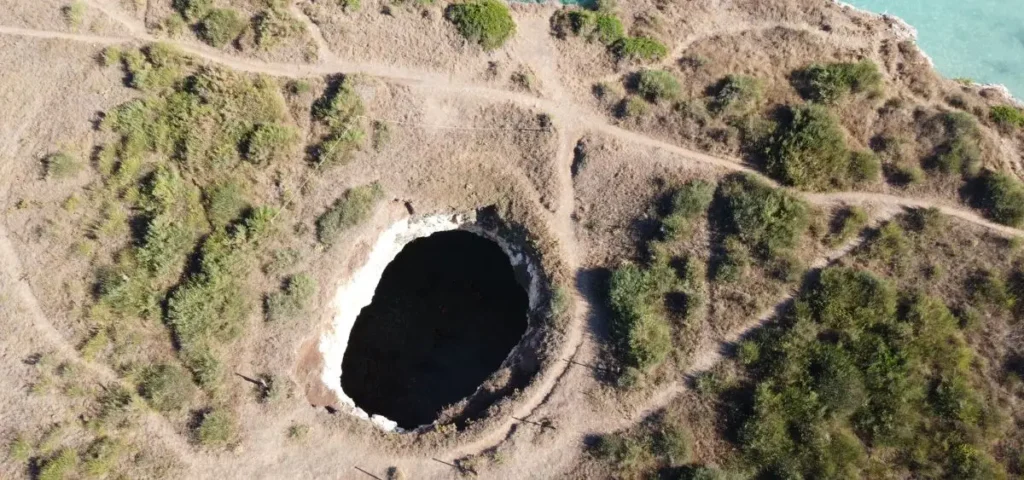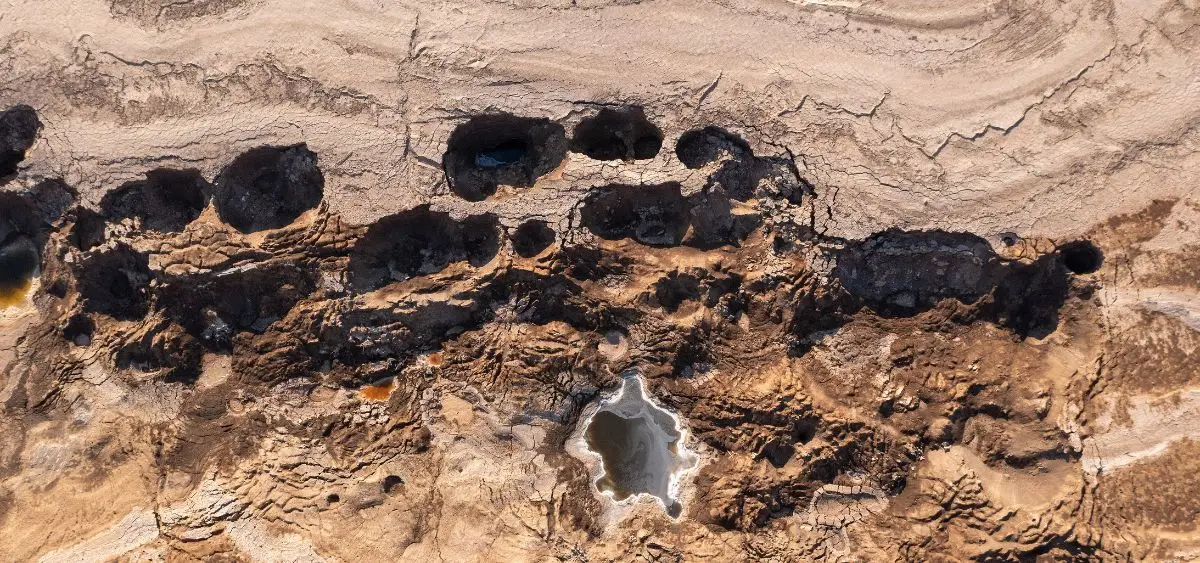The Dead Sea, once a breathtaking natural wonder where you could float without effort and heal your skin with its rich minerals, is now in deep trouble. What was once a symbol of timeless beauty is vanishing year after year, leaving behind cracks in the earth—literally. Sinkholes are swallowing land, water levels are falling, and an environmental emergency is brewing at the lowest point on Earth.
So, what’s causing this collapse? Why is the Dead Sea shrinking so fast? And more importantly—can we still save it? Dive into the full blog below to uncover the truth behind the Dead Sea crisis, explore the science, the sinkholes, and the solutions—and see why this ancient salt lake needs your attention now more than ever.
Also, read: What Is the Dead Sea and Why Doesn’t Anything Live in It?
What Is the Dead Sea Crisis?
The Dead Sea crisis refers to the rapid decline in water levels, the formation of dangerous sinkholes, and the ongoing environmental degradation of this iconic site. Over the past five decades, the Dead Sea has lost more than one-third of its surface area. According to scientists, the water level is dropping by more than one meter every year. This is not just a regional problem—it’s an ecological disaster with global significance.
Why Is the Dead Sea Shrinking?
There are several causes of the Dead Sea crisis, and most of them are man-made.
1. Water Diversion from the Jordan River: The Jordan River used to be the main water source for the Dead Sea. But over the years, Israel, Jordan, and Syria have diverted water for agriculture and drinking. As a result, less freshwater is reaching the lake.
2. Mineral Extraction: Both Israeli and Jordanian companies pump out water to extract minerals like potash and magnesium, further lowering the water level.
3. Climate Change: Rising temperatures and reduced rainfall in the region have accelerated the Dead Sea water crisis. Climate change is drying up natural sources, contributing to the lake’s rapid evaporation.
Also, read: Renewable Energy: Powering a Sustainable Future

Dead Sea Sinkholes: A Serious Problem
One of the most shocking outcomes of this crisis is the formation of thousands of sinkholes around the shoreline. As the water disappears, underground salt layers are left behind. Rainwater seeps in, dissolves the salt, and creates huge empty cavities. These eventually collapse, forming sinkholes as deep as 25 meters.
According to a research, there are over 6,000 sinkholes around the Dead Sea—and the number keeps rising.
These sinkholes are swallowing roads, buildings, and farmlands. It’s no longer safe to explore some areas around the lake, making this a Dead Sea environmental crisis of both economic and human concern.
Environmental Impact of the Dead Sea Crisis
The environmental impact of the Dead Sea crisis is alarming:
- Disruption of natural ecosystems
- Collapse of tourist spots and local businesses
- Loss of biodiversity
- Unsafe land due to sinkhole risk
- Stress on water resources in the Middle East water crisis
The Dead Sea tourism decline is real. Resorts, spas, and beaches have shut down because of unstable ground and disappearing shorelines.
Dead Sea Shrinkage Facts in 2025
- The Dead Sea has dropped over 30 meters in the last 50 years
- Sinkholes are forming at a rate of hundreds per year
- Only about 10% of original freshwater inflow remains
- The surrounding land is losing its value and safety
Also, read: From Plastic to Purpose: A Thoughtful List of Sustainable Swaps
What’s the Future of the Dead Sea?
Is the Dead Sea disappearing? That’s the big question. If current trends continue, the lake will keep shrinking, the sinkholes will increase, and the damage will be irreversible. The Dead Sea problems in 2025 look worse than ever. However, there is hope.

Solutions to the Dead Sea Crisis
- Red Sea–Dead Sea Water Conveyance Project: This ambitious plan proposes pumping water from the Red Sea to the Dead Sea through a canal. It aims to restore water levels and generate hydroelectric power. But the project has faced delays, funding issues, and environmental concerns.
- International Cooperation: Countries in the region must work together to limit water diversion and protect shared resources.
- Sustainable Tourism: Eco-friendly tourism and development can raise awareness while preserving the fragile environment.
- Public Awareness: Global education and pressure are vital to put the Dead Sea crisis on the world’s priority list.
Also, read: Turning Storm-Damaged Wood into Music and Hope – VAIA Cube
FAQs
1.How does the shrinking Dead Sea affect people living nearby?
It leads to land damage, loss of tourism, and destruction of roads and infrastructure due to sinkholes. It also affects agriculture and water availability in the region.
2. Is climate change involved in the Dead Sea crisis?
Yes, climate change plays a role by reducing rainfall in the region and increasing evaporation rates due to rising temperatures.
3. How has tourism been impacted by the shrinking Dead Sea?
Tourism has declined in some areas due to sinkholes and unsafe ground, but other regions are still safe and attract visitors for their natural beauty and spa experiences.
4. Can the Dead Sea be restored naturally?
Not easily. Because of human interventions and reduced inflow from rivers, natural restoration is nearly impossible without active human efforts and cooperation.
5. Is there public awareness about the Dead Sea Crisis?
Awareness is growing, but many people still don’t know the urgency of the crisis. Campaigns, documentaries, and environmental groups are trying to change that.
6. What is the Red Sea–Dead Sea pipeline project?
It’s a proposed pipeline that would carry water from the Red Sea to the Dead Sea. The idea is to refill the Dead Sea, desalinate water, and produce energy. But it’s expensive and politically complicated.
Also, read: Global Crisis! Impact of Climate Change Are Worse Than Expected
Conclusion
The Dead Sea crisis explained here is not just about one lake. It’s a symbol of the broader environmental challenges we face in the modern world. From climate change to unsustainable water use, the Dead Sea reflects a painful truth—natural wonders can vanish if we don’t act. We still have a chance to save it. But that window is closing.










